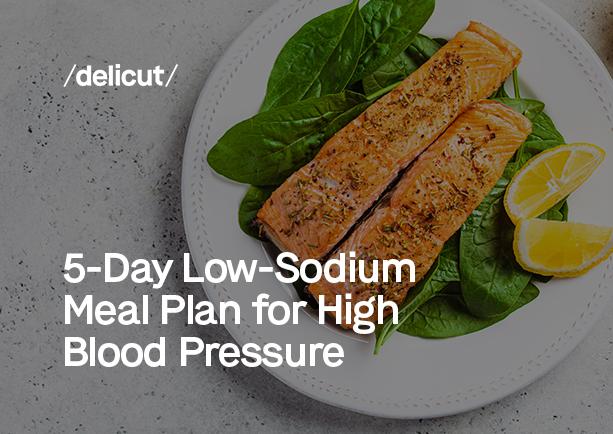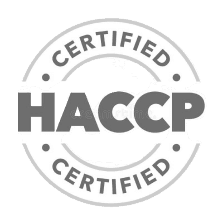5-Day Low-Sodium Meal Plan for High Blood Pressure

High blood pressure, also known as hypertension, affects nearly 30% of adults globally, according to recent statistics from the World Health Organization. In the UAE, the statistic is alarmingly high, with over 35% of the adult population suffering from this silent yet severe condition. Managing blood pressure effectively is crucial to reducing the risk of heart disease and stroke. Adopting a low-sodium diet is one of the most effective strategies for controlling high blood pressure.
This 5-day low-sodium meal plan is designed to help you manage your blood pressure naturally while enjoying delicious and nutritious meals. By reducing sodium intake and focusing on nutrient-rich foods, you can take a significant step towards a healthier, more balanced lifestyle.
How Does Sodium Increase Blood Pressure?
Sodium plays a crucial role in regulating fluid balance in the body. However, consuming too much sodium can lead to an increase in blood pressure, which is a major risk factor for heart disease and stroke.
Here's how sodium affects blood pressure and why it's important to follow a low-sodium meal plan for high blood pressure management:
- Fluid Retention and Increased Blood Volume: When you consume high amounts of sodium, your body retains more water to help dilute the sodium in your bloodstream. This added pressure can damage your blood vessels and strain your heart.
- Impact on Kidney Function: Your kidneys filter excess sodium out of your body. This buildup causes your body to hold more water, increasing blood volume and pressure. Consistently high sodium intake can impair kidney function, exacerbating high blood pressure.
- Vascular Stiffness: High sodium levels can cause blood vessels to stiffen and narrow, making blood flow harder. Over time, this can lead to hypertension and increase the risk of cardiovascular events.
- Hormonal Changes Excessive sodium intake can trigger the release of hormones like aldosterone and angiotensin II, which regulate blood pressure. These hormones cause your blood vessels to constrict, leading to higher blood pressure.
- Long-term Health Risks: Persistent high blood pressure due to excessive sodium consumption can lead to severe health complications such as heart disease, stroke, and kidney disease. By adhering to a low-sodium meal plan for high blood pressure.
Low-sodium 5-day Meal Plan for High Blood Pressure
Day 1: Starting Fresh
Breakfast: Oatmeal with Fresh Berries and Almonds
Ingredients:
- 1 cup rolled oats
- 2 cups water or unsweetened almond milk
- 1/2 cup fresh berries (strawberries, blueberries, or raspberries)
- 1/4 cup sliced almonds
- 1 tsp honey (optional)
Benefits:
- Oats are a great source of soluble fibre, which helps reduce cholesterol and regulate blood pressure.
- Berries add antioxidants and natural sweetness, while almonds provide healthy fats and protein.
Lunch: Quinoa and Black Bean Salad
Ingredients:
- 1 cup cooked quinoa
- 1/2 cup black beans, rinsed and drained
- 1/2 cup chopped bell peppers
- 1/4 cup chopped red onion
- 1/4 cup chopped cilantro
- Juice of 1 lime
- 1 tbsp olive oil
Benefits:
- This salad is high in fiber and protein, which helps keep you full and satisfied.
- Quinoa is a complete protein, and black beans are rich in potassium, which helps balance sodium levels in the body.
Dinner: Baked Salmon with Steamed Vegetables
Ingredients:
- 1 salmon fillet
- 1 tbsp olive oil
- Juice of 1 lemon
- Salt-free seasoning (such as Mrs. Dash)
- Assorted vegetables (broccoli, carrots, zucchini)
Benefits:
- Salmon is rich in omega-3 fatty acids, which benefit heart health.
- Steamed vegetables provide essential vitamins and minerals without added sodium.
Snacks: Greek Yogurt with Honey
Ingredients:
- 1 cup plain Greek yogurt
- 1 tsp honey
Benefits:
- Greek yogurt is a great protein and probiotic source, promoting gut health.
- A touch of honey adds natural sweetness without excessive sugar.
Day 2: Maintaining Balance
Breakfast: Spinach and Mushroom Omelette
Ingredients:
- 2 eggs
- 1/2 cup fresh spinach
- 1/4 cup sliced mushrooms
- 1 tbsp olive oil
Benefits:
- Eggs provide high-quality protein.
- Spinach and mushrooms add fiber and essential nutrients like potassium and magnesium, which are important for blood pressure regulation.
Lunch: Grilled Chicken Wrap with Avocado
Ingredients:
- 1 whole-grain tortilla
- 1 grilled chicken breast, sliced
- 1/2 avocado, sliced
- 1/4 cup shredded lettuce
- 1/4 cup diced tomatoes
- 1 tbsp plain Greek yogurt
Benefits:
- This wrap is rich in lean protein and healthy fats from the avocado.
- Whole grains provide additional fiber to help keep you full.
Dinner: Stir-fried Tofu with Broccoli
Ingredients:
- 1 block of firm tofu, cubed
- 2 cups broccoli florets
- 1 tbsp low-sodium soy sauce
- 1 tbsp olive oil
- 1 tsp minced garlic
Benefits:
- Tofu is a great plant-based protein source, and broccoli is packed with fiber and antioxidants. Using low-sodium soy sauce keeps the dish flavorful without excess sodium.
Snacks: Apple Slices with Peanut Butter
Ingredients:
- 1 apple, sliced
- 2 tbsp natural peanut butter
Benefits:
- Apples are rich in fiber and vitamins, while peanut butter provides healthy fats and protein.
- This snack is both satisfying and nutritious.
Day 3: Midweek Boost
Breakfast: Smoothie with Banana, Spinach, and Almond Milk
Ingredients:
- 1 banana
- 1 cup fresh spinach
- 1 cup unsweetened almond milk
- 1 tbsp chia seeds
Benefits:
- This smoothie is packed with potassium, fiber, and antioxidants.
- It's a great way to start the day with a boost of energy and nutrients.
Lunch: Lentil Soup with Whole Grain Bread
Ingredients:
- 1 cup cooked lentils
- 4 cups low-sodium vegetable broth
- 1 cup diced carrots
- 1 cup diced celery
- 1/2 cup diced onions
- 1 tbsp olive oil
- 2 slices whole grain bread
Benefits:
- Lentils are high in fiber and protein, making this soup filling and nutritious.
- Whole-grain bread adds additional fiber and nutrients.
Dinner: Turkey Meatballs with Zucchini Noodles
Ingredients:
- 1 lb ground turkey
- 1 egg
- 1/4 cup whole wheat breadcrumbs
- 2 zucchinis, spiralised
- 1 tbsp olive oil
- 1 cup low-sodium marinara sauce
Benefits:
- Turkey is a lean protein, and zucchini noodles are a low-carb alternative to pasta.
- This meal is both hearty and healthy.
Snacks: Carrot and Cucumber Sticks with Hummus
Ingredients:
- 1 cup carrot sticks
- 1 cup cucumber sticks
- 1/4 cup hummus
Benefits:
- This snack is rich in fiber and vitamins; hummus provides protein and healthy fats.
Day 4: Energizing Meals
Breakfast: Avocado Toast on Whole Grain Bread
Ingredients:
- 1 slice whole grain bread
- 1/2 avocado, mashed
- 1 tbsp chia seeds
Benefits:
- Avocado is rich in healthy fats and fiber.
- Whole-grain bread provides additional nutrients and keeps you full longer.
Lunch: Tuna Salad with Mixed Greens
Ingredients:
- 1 can tuna in water, drained
- 2 cups mixed greens
- 1/4 cup diced celery
- 1/4 cup diced red onion
- 1 tbsp olive oil
- Juice of 1 lemon
Benefits:
- Tuna is high in protein and omega-3 fatty acids.
- Mixed greens add fiber and essential nutrients.
Dinner: Baked Chicken with Quinoa and Asparagus
Ingredients:
- 1 chicken breast
- 1 cup cooked quinoa
- 1 cup asparagus, trimmed
- 1 tbsp olive oil
- Salt-free seasoning
Benefits:
- This meal balances lean protein, whole grains, and vegetables.
- Quinoa is a complete protein, and asparagus is rich in vitamins.
Snacks: Mixed Nuts (unsalted)
Ingredients:
- 1/4 cup mixed nuts
Benefits:
- Nuts are a great source of healthy fats, protein, and fiber.
- Choosing unsalted varieties keeps sodium intake low.
Day 5: Finishing Strong
Breakfast: Greek Yogurt with Nuts and Seeds
Ingredients:
- 1 cup plain Greek yogurt
- 1/4 cup mixed nuts and seeds
- 1 tsp honey (optional)
Benefits:
- Greek yogurt is high in protein and probiotics.
- Nuts and seeds add healthy fats and fiber.
Lunch: Chickpea Salad Wrap
Ingredients:
- 1 whole-grain tortilla
- 1 cup mashed chickpeas
- 1/4 cup diced cucumbers
- 1/4 cup diced tomatoes
- 1 tbsp olive oil
- Juice of 1 lemon
Benefits:
- Chickpeas are high in protein.
- Fiber, makes this wrap both filling and nutritious.
Dinner: Grilled Shrimp with Brown Rice and Vegetables
Ingredients:
- 1 cup grilled shrimp
- 1 cup cooked brown rice
- 1 cup mixed vegetables (bell peppers, broccoli, carrots)
- 1 tbsp olive oil
Benefits:
- Shrimp is a lean protein source, and brown rice provides whole grains.
- Mixed vegetables add fiber and essential nutrients.
Snacks: Fresh Fruit Salad
Ingredients:
- 1 cup mixed fresh fruit (berries, melon, kiwi)
Benefits:
- Fresh fruit is hydrating and rich in vitamins and antioxidants.
- It is a perfect snack to end the day.
Conclusion
By following this 5-day low-sodium meal plan, you can take significant steps towards managing your blood pressure naturally. Each meal is designed to be nutritious and delicious, ensuring you don't feel deprived while working towards better health. Consider a healthcare professional before making any major changes to your diet, and enjoy the benefits of a balanced, low-sodium lifestyle.
FAQs
1. How can a low-sodium meal plan help lower blood pressure?
A low-sodium meal plan helps reduce the amount of excess fluid in the body, easing the workload on the heart and blood vessels, which can lead to lower blood pressure. It also helps prevent hypertension-related complications like heart disease and stroke.
2. What are some common sources of hidden sodium in foods?
Common sources of hidden sodium include processed and packaged foods, canned soups, condiments, deli meats, and fast food. Even items that don’t taste salty, like bread and cereals, can contain significant amounts of sodium.
3. How much sodium should I consume daily to manage high blood pressure?
Consuming no more than 1,500 milligrams of sodium per day is recommended for managing high blood pressure. This helps keep blood pressure levels in check and reduces the risk of cardiovascular diseases.
4. Can I still enjoy flavorful meals on a low-sodium meal plan?
You can enjoy flavorful meals using herbs, spices, lemon juice, and salt-free seasoning blends. These alternatives enhance the taste of food without adding sodium, allowing you to enjoy delicious meals.
5. How do I read food labels to identify high-sodium products?
To identify high-sodium products, check the Nutrition Facts label for the amount of sodium per serving. Aim for products with 5% or less of the daily value (DV) of sodium per serving, and avoid those with 20% or more DV.
6. What are some healthy breakfast options for a low-sodium meal plan?
Healthy low-sodium breakfast options include oatmeal with fresh berries and almonds, a spinach and mushroom omelet, and a banana, spinach, and almond milk smoothie.
Read More:
30-Day Balanced Meal Plan for a Healthy Pregnancy
Gut Health Meal Plan: 20 Days to Better Digestive Wellness
30-Day Muscle Gain Meal Plan: Build Strength and Muscle
7 Day Quick and Easy Vegetarian Dinner Meal Plan: Simple & Delicious Recipes
7-Day Quick and Easy Seafood Dinner Meal Plan: Delicious & Nutritious
Related Blogs
Why do most people in the UAE get their calories wrong
Dec 8, 2025 | 6DASH Diet Meal Plan
Nov 11, 2025 | 8Fatty Liver Meal Plan
Oct 31, 2025 | 8Pregnancy Diet Meal Plan
Oct 27, 2025 | 82000 Calorie Meal Plan
Oct 1, 2025 | 8Intermittent Fasting Diet Plan
Sep 5, 2025 | 81000 Calorie Meal Plan
Sep 5, 2025 | 8High-Protein Meal Plans
Sep 5, 2025 | 8How to Choose the Right Meal Plan for Your Fitness Goals
Sep 5, 2025 | 8The GM diet plan: Is it possible to shed fat in just 7 days?
Sep 5, 2025 | 8






